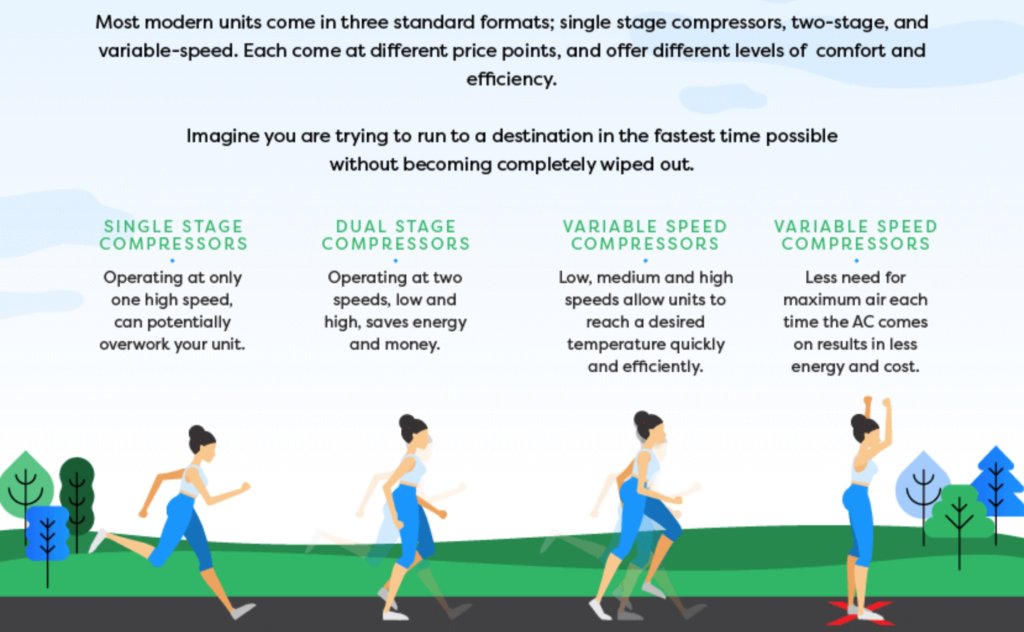What’s the difference: Variable Speed vs. Two-Stage vs. Single-Stage HVAC Systems
When it comes to choosing an HVAC system, there’s a certain amount of vocabulary to navigate. If you’ve heard about variable speed and multi-stage systems and are wondering what those words mean and which one is right for you, then learn more. If you’re looking to purchase an HVAC system such as an air conditioner or heat pump, you’ve likely come across the terms variable speed, two-stage, and single-stage – but, what do they mean? To further complicate things, you might even see words like two-speed or single-speed while doing your research, too.
What all these terms are really referring to is the capacity at which your HVAC system is able to operate as it cools your home, and that’s all determined by the number of stages on the system’s compressor. Single-stage or speed systems have a compressor that can only operate at one setting. Meanwhile, two-stage or speed systems have compressors with two settings, and variable speed systems have compressors with multiple settings. Learn the key differences among these three systems, plus how to know which is best for your home.
What is a single-stage system?
Single-stage, or single-speed, systems are the most basic systems. They have two settings: on or off, meaning they operate at full capacity or not at all. These systems work at full speed to cool down hot outdoor temperatures that impact your home, as the system shuts off completely once the indoor temperature has cooled down. Because of the frequent switch from on to off, and because they can only operate at 100% max speed, single-stage systems are usually the most expensive to operate. For homeowners interested in a single-stage system, National Air Warehouse offers systems ranging in efficiency from 13 to 15 SEER2.
What is a two-stage system?
Two-stage, or two-speed, systems take single-stage systems up a notch and control the temperature in your home a bit more accurately. While single-stage systems must be at either 0 percent or 100 percent capacity, two-stage systems add more variety by offering a high and low setting. In most cases, the low stage operates around 65 percent capacity, while the high stage operates at 100 percent capacity. Compared to single-stage systems, the two-stage system offers a middle ground for temperature control.
What is a variable speed system?
Variable speed, or variable stage, systems are the most efficient and advanced systems on the market. When you set a temperature on your thermostat, a variable speed system takes into account the indoor and outdoor temperatures, the indoor and outdoor humidity levels, and the run time needed to reach your desired temperature, in order to determine the appropriate output. Variable speed systems can operate anywhere from 25 percent capacity to 100 percent capacity to meet your temperature needs. Variable speed systems reach and maintain your home’s desired temperature within half a degree, and because they can operate at lower speeds, they consume less power, which makes them the least expensive to operate over time. If you’re looking for a variable speed system, Rheem and Goodman are popular choices.
What to consider when choosing a system
Now that you know a bit more about each type of system, the next step is choosing which one is right for your home. Consider these factors so you can make the best purchase possible for your home.
Cost
Cost typically plays a significant role in most purchases, and your HVAC system isn’t any different. While single-stage systems are the lowest in cost upfront, they’ll cost more to operate in the long run. On the flip side, variable speed systems are the most expensive option upfront, but cost less to operate since they run on a lower operating speed and draw less power most of their operating runtime. Two-stage systems are the middle ground for both upfront cost and cost overtime.
Energy efficiency
Energy efficiency is an important measure to consider, as the more energy efficient your system, the less it’ll cost you in utility bills. Single-stage systems are the least energy efficient because they must operate at 100 percent capacity when they’re on. Since two-stage systems operate at a high and low setting, they use less energy than single-stage systems, but more energy than variable speed systems. Variable speed systems are the most energy efficient.
Humidity control
Too much or too little humidity in your home can have negative consequences, so it’s crucial your HVAC system can keep your indoor humidity at an optimal level. Two-stage systems are more efficient in removing moisture in the air than single-stage systems, which reduces humidity in the home. But, like most factors on this list, variable speed systems are the best at regulating humidity and are ideal for people living in high humidity environments.
Choosing the right HVAC system for you
Now that you have more information about the differences among single-stage, two-stage, and variable speed systems, you can choose the right HVAC system for your home. As you have learned, climate, energy efficiency, your geographic location, and budget can all play a role in helping you determine which system best fits your unique needs. Reach out to an expert HVAC technician for more detailed information and guidance.
HVAC Sizing Calculator
Blog Center
Featured Brands
Deals of the Day!


Which stage system do you think is best for people who live in Florida?
The BEST option with the highest comfort and energy savings is a variable speed AC, which is recommended for many Florida homeowners. However variable-speed AC’s are more pricey than single-stage or two-stage AC’s and for that reason, homeowners sometimes cross the variable-speed options off their list.